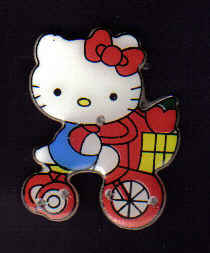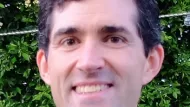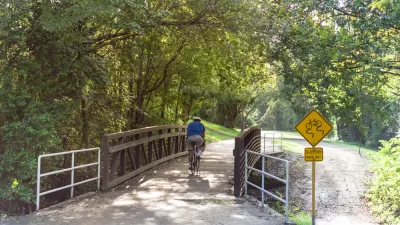Now that the weather in Los Angeles has gone from pleasant to perfect with the subtle advent of spring, I've been spending more time risking my life atop my bicycle as I wend my way to meetings and errands. As a faithful urbanist I have little trouble convincing myself of cycling's merits, which, as former California State Health Officer Dr. Richard Jackson likes to say, can "improve your life span, lower your blood pressure, make you better looking, improve your sex life, and save you money." Sounds good to me.
Now that the weather in Los
Angeles has gone from pleasant to perfect with the subtle advent of
spring, I've been spending more time risking my life atop my bicycle as
I wend my way to meetings and errands. As a faithful urbanist I have
little trouble convincing myself of cycling's merits, which, as former
California State Health Officer Dr. Richard Jackson likes to say, can
"improve your life span, lower your blood pressure, make you better
looking, improve your sex life, and save you money." Sounds good to
me.
But Dr.
Jackson's catalog of virtues is complicated by, among other things,
crumpled pavement, oblivious drivers, cramped roadways, ridicule, and
perspiration. In Europe, where they do things better, cycles have
their own lanes on the sidewalks (not in the streets -- duh) and even
their own traffic signals, thus allowing men and women, young and old
to pedal to their hearts' content through the central cores of Berlin,
Vienna, Amsterdam, and, of course, Copenhagen.
While a few
Americans are having sexy time in Portland and Boulder, most American
cities couldn't embrace cycling even if they wanted to. Sidewalks are
not wide enough (unless we get rid of devil strips), and most traffic and parking lanes are spoken for. But
inappropriate infrastructure isn't really the problem. Focusing on
infrastructure in the first place is the problem. The visceral thrill
that planners and captains of industry get from pouring concrete and
erecting things -- no matter how ugly or useless -- has led to the
assumption that all solutions must be material solutions. But, as with
so many other problems that only seem to be grounded in the built
environment, safer, more pleasant cycling should start with more
ephemeral reforms.
I am the furthest thing from a gearhead. My
regular destinations include the gym, Starbucks, the bank, and maybe
the beach. But from these modest transits I have come up with a few
common-sense programs and attitudinal shifts that could, every so
often, get a few more intrepid souls out of their cars and on to their
bikes.

The Cycle-Industrial Complex: Not all corporations are
evil. Corporations are only as evil as their products, which is why I
don't like General Motors, Northrop Grumman, or Juicy Couture. But if
it's Trader Joe's, Sanrio, or Schwinn, bring it on. Schwinn's parent
company, Dorel Industries, posted $100 million in
profits in 2007. Given that it costs only $1.3 million to buy the
presidency and prompt the invasion of a nation,
Doral and its competitors could make a fortune and do the world some
good by paying off lobbying politicians to promote bicycle-friendly projects and
policies. If it worked for the railroads in the 19th century and the
auto companies in the 20th, why not the bicycle companies in the 21st?
Sartorial Infrastructure: Albert Einstein notwithstanding, one of the greatest impediments to practical cycling
greatest impediments to practical cycling
centers not on roads but on threads. The ride from my apartment to the
bus that would take me to work is a half-mile downhill. In a business
suit, it might as well be 1,000 miles of open ocean. Decorum and social
convention dictate that many people cannot ride a bike to work under
any circumstances, but I would hope that America's vaunted business
culture will, someday, become relaxed enough to allow employees and
executives alike to dress in such a way as to send a few fewer dollars
to Saudi Arabia.
Temporary Urbanism: Most cities have some kind of half-assed "bicycle boulevard" or "bike route." Inexplicably, these routes sometimes amount to no more than few signs. If we're lucky, we get bike lanes. In a perfect world, however,
cities would reserve entire streets for bicycles. Cars could have major
thoroughfares, and then smaller parallel streets (perhaps residential
streets) could serve only bicycles (with accommodations for local
access, etc.). Such a transformation would require little more than
PR, signage, and paint, but it's a pipe dream because locals would invariably oppose such an outrageous deviation from the comfort
of the inanity to which we are accustomed. But here's a compromise:
Cities could institute bicycle streets on a temporary basis, once per
week, or once per month. Whereas infrastructure is scary because it is
expensive and permanent, a fiat to prohibit cars on certain streets (or
even certain lanes -- one lane of parking would suffice) on certain
days would be a reasonable compromise in an age when compromise is rare
and a field in which permanence is next to godliness. But if it can
work for farmers markets and 5K races, then it might work for
commuting. Furthermore, these occaisional occurances would be events that cyclists could plan for, and it would create the sort of crtitical mass that the Critical Mass folks are trying to promote.
Partial Urbanism: I said I wasn't going to fetishize infrastructure,
but, then again, paint isn't quite in the same league as concrete and
rebar. The width of one parking lane corresponds to two opposing lanes
of bike traffic. Engineers seem to have a fetish for symmetry, but the
elimination of a single parking lane on one side of a street can result
in an entire bike lane. Depending how it was striped and signed, it
could even apply only during certain hours or, as mentioned above,
certain days.
Bike n' Bus: If you want people in L.A. to think you're crazy, tell them that you take the bus. And if you really want them to think you're crazy, tell them that you bike to work. Lunacy nothwithstanding, Los
Angeles's one true triumph is in equipping all local buses with bike
racks, which mean that as long as you're willing to take the risk, you
can go pretty much anywhere in the city. Of course, this requires
combating the double stigma of cycling and riding the bus -- which is a
fate worse than death for your average member of the urban bourgeoisie.
Yet again, though, the solutions are close at hand for anyone with even
the slightest sense of adventure and social responsibility.
Bike Racks: Duh. For the cost of one parking space in every apartment building, minimall, and office building in L.A., everyone who has ever dreamed of cylcing would have a place to park. And, no, I won't hit your Mercedes.
The Cool Factor: This is one PR campaign that all the spin in the
world probably couldn't win. Prisses in Bentley coupes and tough guys
probably couldn't win. Prisses in Bentley coupes and tough guys
in raised pickup trucks will always think cyclists are hopelessly lame.
But with gas topping $4 and congestion thickening, cyclists just have to
keep in mind who the real douchebags rugged invididualists are.

Maui's Vacation Rental Debate Turns Ugly
Verbal attacks, misinformation campaigns and fistfights plague a high-stakes debate to convert thousands of vacation rentals into long-term housing.

Planetizen Federal Action Tracker
A weekly monitor of how Trump’s orders and actions are impacting planners and planning in America.

In Urban Planning, AI Prompting Could be the New Design Thinking
Creativity has long been key to great urban design. What if we see AI as our new creative partner?

King County Supportive Housing Program Offers Hope for Unhoused Residents
The county is taking a ‘Housing First’ approach that prioritizes getting people into housing, then offering wraparound supportive services.

Researchers Use AI to Get Clearer Picture of US Housing
Analysts are using artificial intelligence to supercharge their research by allowing them to comb through data faster. Though these AI tools can be error prone, they save time and housing researchers are optimistic about the future.

Making Shared Micromobility More Inclusive
Cities and shared mobility system operators can do more to include people with disabilities in planning and operations, per a new report.
Urban Design for Planners 1: Software Tools
This six-course series explores essential urban design concepts using open source software and equips planners with the tools they need to participate fully in the urban design process.
Planning for Universal Design
Learn the tools for implementing Universal Design in planning regulations.
planning NEXT
Appalachian Highlands Housing Partners
Mpact (founded as Rail~Volution)
City of Camden Redevelopment Agency
City of Astoria
City of Portland
City of Laramie






























